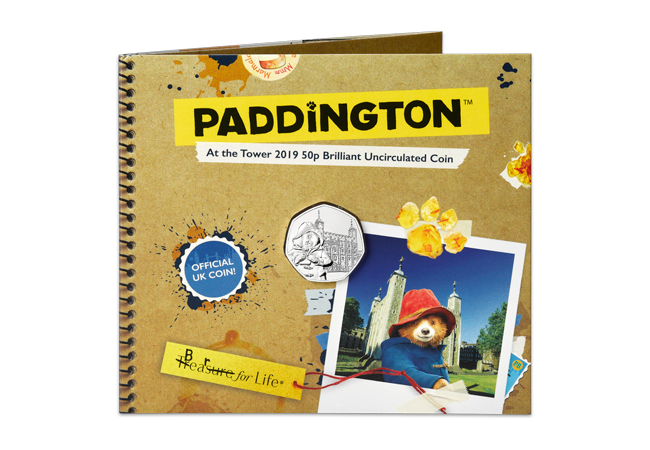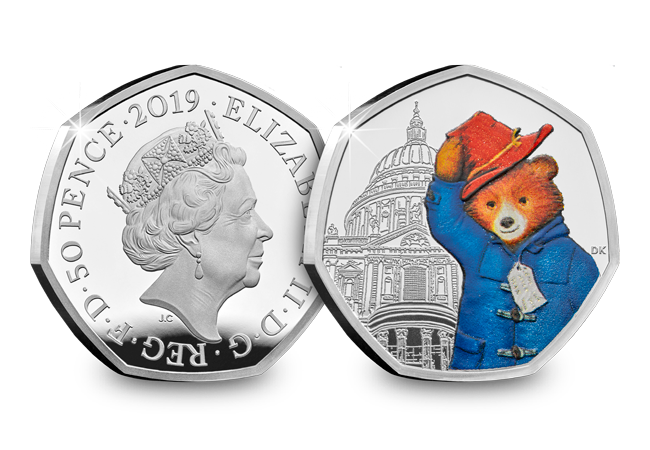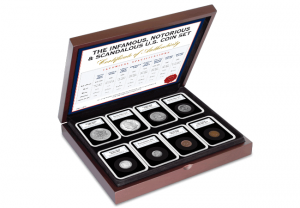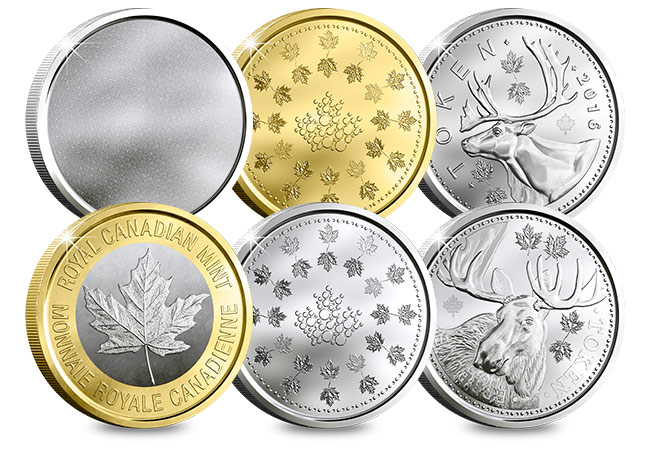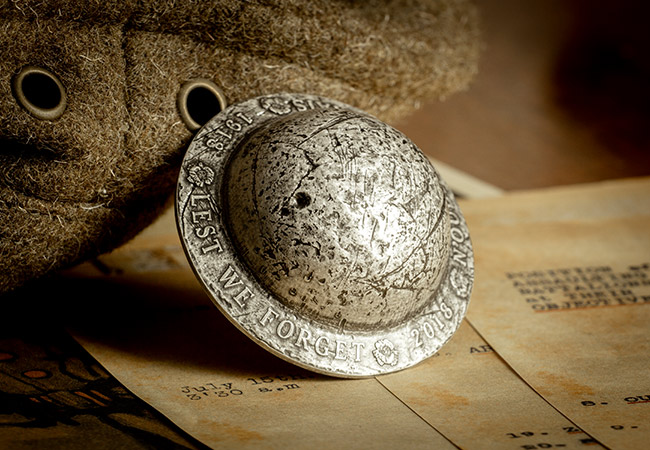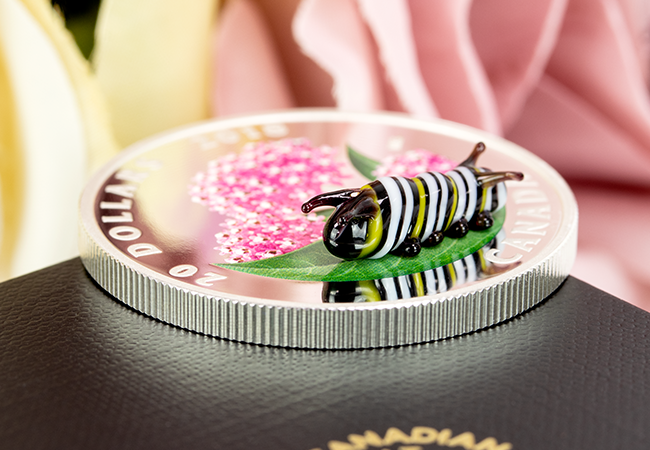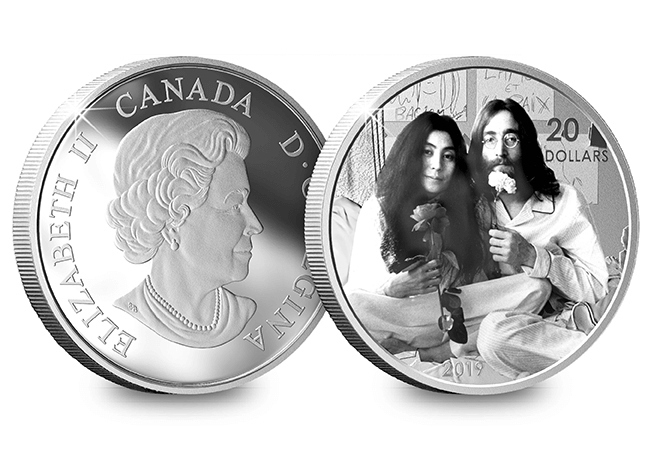Information
Paddington returns in 2019 for two more adventures!
For over 60 years Paddington, the famous bear from deepest darkest Peru, has been beloved by children and big-kids across the globe. Since Michael Bond gave him life in 1958, Paddington has featured in more than twenty books, including being translated into thirty languages and selling over thirty million copies worldwide!
On 11th April the Royal Proclamation confirmed that Paddington’s adventures in London would continue this year with two brand new 50ps.
And today, we’re delighted to reveal the brand new designs with you! Plus of course, letting you know how you can add these new UK 50p coins to your collection.
Paddington at the Tower
The first new design to be released today, 13th August 2019, features Paddington at his third iconic London destination – the Tower of London. You’ll see the most British of bears tucking in to his signature marmalade sandwich outside the famous fortress which is engraved in intricate detail.
This new 50p is available to own today in a range of specifications. Find out more about each of them below…
Paddington at the Tower Limited Edition Silver Proof 50p
This is the ultimate way to own this new Paddington coin! Thanks to the use of colour printing minting technology, everyone’s favourite bear, and his iconic red hat and blue coat, are brought to life perfectly in vibrant full colour detail.
Each coin has been expertly struck from .925 sterling silver to a perfect proof finish and is beautifully displayed in a contemporary Perspex block complete with bespoke Paddington themed packaging.
Importantly, just 25,000 single coins will ever be issued worldwide. Considering the rapid sell-out of The Gruffalo Silver Proof 50p that was released earlier this year with the same edition limit – 25,000 – collectors will need to be quick to secure one for their collection. You can order this limited edition coin for the Royal Mint issue price of just £65 (+p&p). Click here to secure yours >>
Paddington at the Tower Brilliant Uncirculated Collector’s Pack
The Royal Mint has also issued this coin in a special collector’s pack, including the coin in Brilliant Uncirculated quality. This finish is coveted by collectors as it means each coin is free from any marks you would find on circulated coins.
Each one is protectively encapsulated in its attractive official Royal Mint packaging to preserve its quality for generations to come. What’s more, you can secure this BU Pack at the Royal Mint issue price of just £10 (+p&p). Click here to order your pack >>
Paddington at St Paul’s
The second design to be revealed for 2019 – making it the fourth in the series – shows Paddington doffing his battered old bush hat (I suspect there is a marmalade sandwich hiding in there!) outside the iconic dome that’s instantly recognisable as St Paul’s Cathedral.
It has been confirmed this coin will be officially launched later in the year. But I’m delighted to offer you the opportunity to beat the queues and pre-order this coin today. Making you one of the first collectors in the country to secure one for your collection!
Paddington at St Paul’s Limited Edition Silver Proof 50p
Each coin comes beautifully presented and ready to display in its bespoke Royal Mint packaging. The coin is struck from .925 sterling silver to a perfect proof finish and features a charming full-colour image of Paddington at St Pauls.
Again, just 25,000 single coins will ever be issued worldwide. Given the record-breaking sell out of The Gruffalo Silver Proof 50p with the same edition limit, you really will need to act quickly to add this to guarantee you don’t miss out. You can secure this limited edition coin for the Royal Mint issue price of just £65 (+p&p). Click here to pre-order yours >>
All pre-ordered coins will be despatched after the coin has officially launched and is available for purchase worldwide on 12th September. If you pre-order your coin today you won’t be charged until the coin is despatched, meaning you pay no money now.
Paddington at St Paul’s Brilliant Uncirculated Collector’s Pack
The Royal Mint has also issued this coin in Brilliant Uncirculated quality. Collectors covet this finish as it means each coin is free from any marks you would find on circulated coins.
Each one is protectively encapsulated in its attractive original Royal Mint packaging to preserve its quality for generations to come. What’s more, you can secure this BU Pack at the Royal Mint issue price of just £10 (+p&p). Click here to reserve your pack >>
All pre-ordered coins will be despatched at a later date once this coin has officially launched and is available for purchase on 12th September. If you pre-order your coin today you won’t be charged until the coin is despatched, meaning you pay no money now.
Given the collecting frenzy generated by the release of the 2018 Paddington coins, it is highly advised that you secure your favourite coins from the range today. This is especially the case for the limited edition Silver Proof 50p coins which are renowned for their rapid sell-outs.
Celebrate Fourth of July with America’s most iconic coins
US coin collecting is one of the most competitive markets globally, which is no surprise given that the coins have some of the most interesting and iconic stories in the coin collecting world. US coins are in extremely high demand, especially in the UK where they rarely make it onto our shores.
As Americans celebrate their independence this week, I have picked out 5 of my favourite US coins to share with you.
The Flowing Hair Dollar
8 of the top 10 most expensive coins ever sold are American, with the Flowing Hair Dollar (1794-5) taking the top spot after it sold for an impressive $10,016,875. It’s thought that only 140 of these remarkable coins exist, so it is near on impossible to find one.
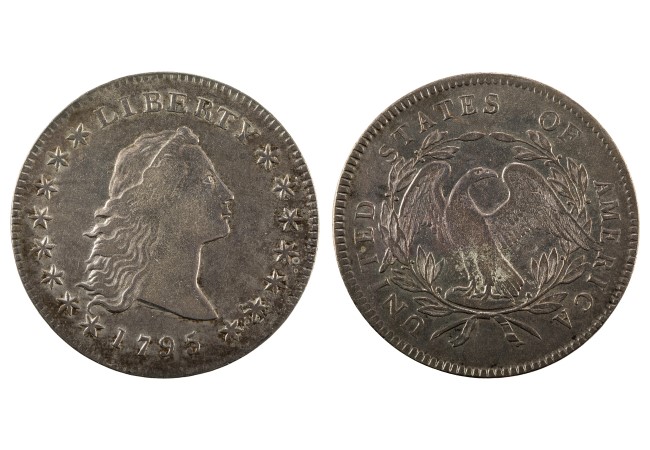
This coin was the first dollar coin ever issued by the United States Federal Government and featured an eagle and the bust of Liberty with flowing hair. It was minted in silver and its size and weight were based on the Spanish dollar, which was traded with regularly in the Americas.
The Morgan Dollar 1878-1921
The Silver Morgan Dollar has forever been associated with cowboys and outlaws. These coins could have been used for gambling by train robbers like Butch Cassidy or Jesse James. It’s even rumoured that cowboys would place them in their canteens to preserve water on long journeys.
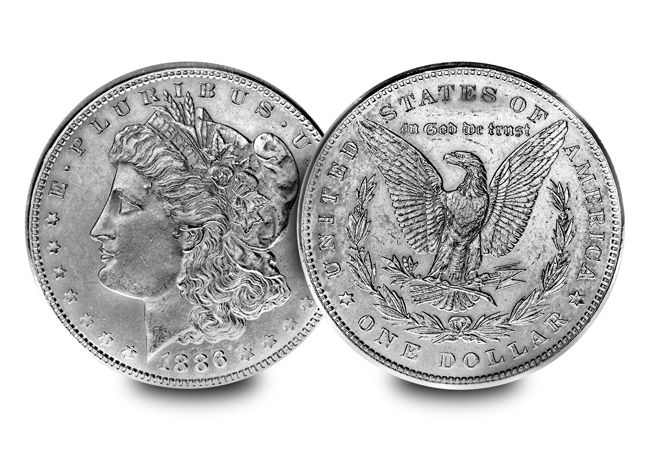
The dollar drew its name from its designer “George T Morgan”, who created an effigy of Lady Liberty as a Goddess, and a reverse which included an eagle with outstretched wings. It’s said that less than 1 in 5 of these coins remain today, making them incredibly collectable and difficult to source.
‘No Cents’ Liberty Head Nickel 1883
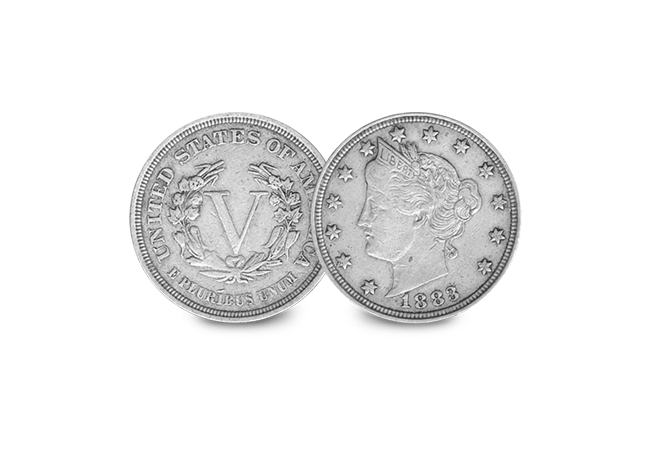
The first design for the No Cents Nickel failed to include the denomination and instead it included the Roman Numeral ‘V’. As the coins were the same size as a $5 coin, swindlers seized the opportunity to gold plate these coins and pass them off as $5 coins. Within the year the US Mint added the denomination to the coin.
The Roosevelt Dime 1946-64
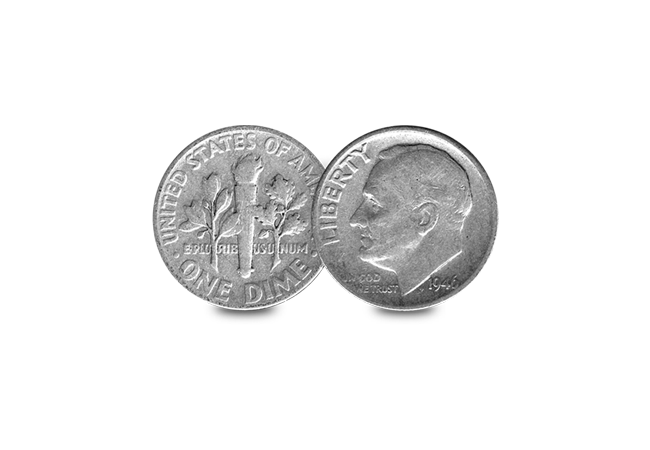
After the death of Franklin Roosevelt in 1945, the nation’s only four term president, his portrait was subsequently used on Dimes as a memorial.
During his presidency, Roosevelt founded ‘March of the Dimes’, a charity founded in response to polio epidemics. Roosevelt’s image was chosen for the Dime in honour of his work with the charity, and his own battle with polio. This coin was symbolic for a nation in mourning, and many people collected the coin from their change.
The Franklin Half Dollar 1948-1964
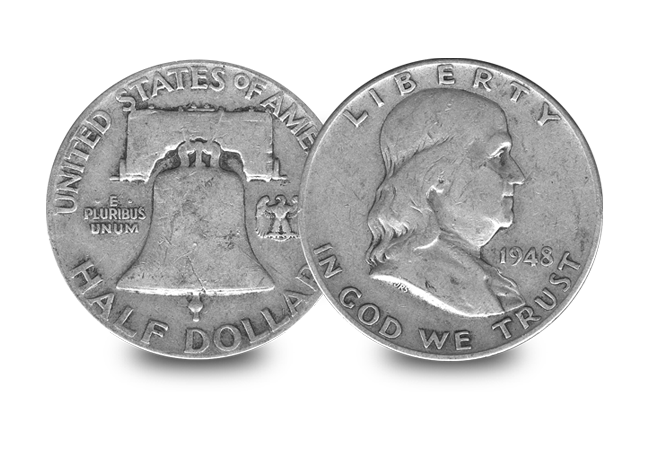
This was the first half dollar to feature the portrait of a non-president on American Coinage. The words ‘Liberty, in God we trust’ surround a portrait of Benjamin Franklin, with the Liberty Bell on the reverse. This was initially a controversial coin, and there were public concerns about the initials of the designer ‘JRS’ being a reference to Stalin and communism, as well as the small eagle placed next to the bell.
American coins give us some of the most interesting stories in history, and provide us with some of the most fascinating and collectable coins in the world. It’s no wonder that US coin collecting is becoming increasingly popular.
If you’re interested…
You can own a selection of America’s most fascinating and infamous coin issues with the Infamous US coins set. Click here to see the other coins and secure yours today>>>
Happy Canada Day!
When I think of Canada several things spring to mind: the iconic maple leaf, the caribou and beaver, ice hockey and Celine Dion, just to name a few. But at the top of my list is without a doubt the Royal Canadian Mint.
As one of the three ‘Royal’ Mints in the world – alongside The Royal Mint here in the UK and the Royal Australian Mint – they are known for their innovation and impressive minting techniques, resulting in some of the most magnificent issues I’ve ever seen.
So to celebrate Canada Day, I’ve rounded-up my top five favorite Canadian releases, each demonstrating why they are one of the most prestigious mints in the world. Believe me, some of these issues are truly incredible!
Take a look for yourself…
The R&D Security Test Token Set
It will come as no surprise to know that the Royal Canadian Mint is the market leader in numismatic security.
The R&D Test Token set offers us a glimpse at never-before-seen minting techniques which will shape our future coins, and are sure to impress even the most seasoned coin collectors.
Included are six specimen tokens with high-tech design elements showcasing fascinating examples of tri-metal technology and micro-text. What’s more, each token included in the set is a real life trial piece which has been used in laboratory testing. So each set is completely unique – no two will be the same! Click here to find out more >>
Lest We Forget Silver Helmet-Shaped Coin
This issue truly is one of a kind. The minting expertise required to strike such an impressive coin is astounding – I’ve never seen a coin like it.
Not only is it struck from the Mint’s signature .9999 Pure Silver, but it’s an incredible miniature replica of the steel Brodie helmets worn by British and Commonwealth forces during the First World War.
How the Mint achieved this result I will never know – it remains a closely guarded secret. There are even engraved cracks and markings you would find on an original helmet. The final antique finish gives an authentic distressed look, the fine detail is incredible. Click here to find out more >>
Pure Silver D-Day Coin
The first step in to battle takes incredible courage, and this year to mark the landmark 75th anniversary of D-Day the Royal Canadian Mint issued perhaps the most poignant D-Day commemorative yet.
This stunning issue perfectly captures the moment Canadian soldiers set foot on Juno Beach. It is expertly struck from a quarter ounce of .9999 Pure Silver – or “four nines Silver”, the purest grade available for which the Mint is known – and has an innovative reverse proof finish which replicates the texture of the sand. Click here to find out more >>
3D Monarch Caterpillar Coin
Some of nature’s most beautiful things come in small packages. And this remarkable issue is no different.
The Monarch Caterpillar Pure 1oz Silver Coin is a perfect combination of Italian craftsmanship and Canadian design. It features a stunning 3D Monarch Caterpillar handcrafted from Murano glass, poised upon the selectively coloured design of a swamp milkweed plant leaf.
The combined traditional engraving, colour and Murano glass creates a truly unforgettable piece. Click here to find out more >>
John Lennon Silver 1oz Coin
It’s hard to believe that just 50 years ago, John Lennon and Yoko Ono conducted their “Bed-in for Peace” protest against the Vietnam War and debuted the most famous anti-war anthem of all time – Give Peace a Chance.
It was a moment that has forever cemented a bond between John Lennon and Canada. A bond that is marked by the release of this limited edition John Lennon commemorative.
Using bespoke printing technology the coin features a photographic image of John and Yoko during their protest and is struck from 1oz Pure Silver to a mirror-like proof finish.
Considering the worldwide popularity of John Lennon and the legacy of Give Peace a Chance, it comes as no surprise that this coin has been incredibly popular. Click here to find out more >>
But that’s not all! There’s plenty of other fantastic coins that have been issued by the Royal Canadian Mint. You can take a look at the full range by clicking here >>


